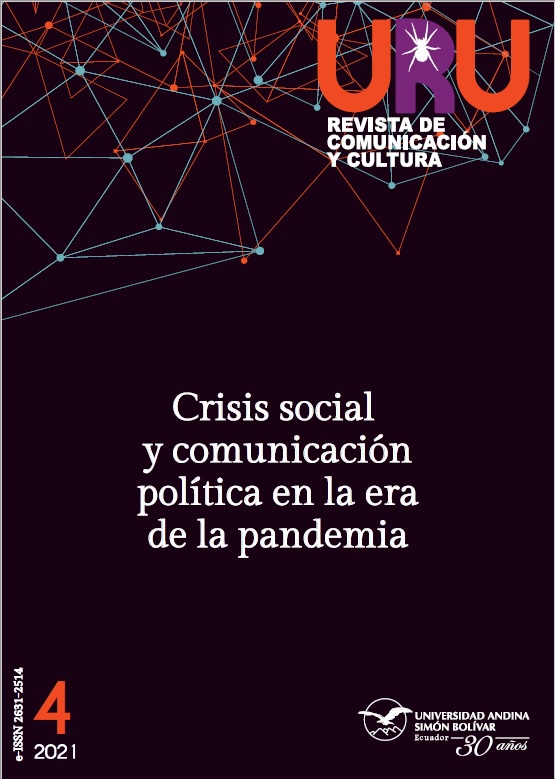Venezuelan Migration in Journalistic Discourse
DOI:
https://doi.org/10.32719/26312514.2021.4.10Keywords:
human mobility, social representations, discourse analysis, news, mediaAbstract
The social, political and economic conditions of Venezuela have caused its population to have made the decision to emigrate to other nations, including Ecuador. As it is an issue that affects different social spheres, it has been addressed by different media. Within the present study, it was analyzed how the journalistic discourse of the newspaper La Nación is constructed, in relation to the migratory process of the Venezuelan population to Ecuador and how this influences the creation of social representations? The study methodology focused on the application of the Technical Communicational Version, in order to delve into the problem, the context and the actors around the communication medium, in addition, the principles of critical discourse analysis were taken into account to identify the representations present in the journalistic discourse related to the immigration issue, a total of 4 informative notes were analyzed. The results showed that the approach, language, intentionality and discursive production of the migration issue will generate
in the audience the creation of biased social representations about the reality of migrants, making them invisible and ignoring the context of their situation.
Downloads
References
Berger, Peter, y Thomas Luckmann. 1986. La construcción social de la realidad. Buenos Aires: Amorrortu.
Bermúdez, Yovanny, Rina Mazuera, Neida Albornoz, y Miguel Morffe. 2018. Informe sobre la movilidad humana venezolana. Realidades y perspectivas de quienes emigran. Lima: CEPAL.
Cajas, Verónica, Consuelo Casimiro, y Lorenzo Pasquel. 2017. “Las representaciones sociales y el discurso noticioso de la Ley Universitaria - Perú”. Comunic@cción 8 (2): 94-104. https://bit.ly/3fmifMC.
Calsamiglia, Helena, y Amparo Tusón. 2001. Las cosas del decir. Manual de análisis del discurso. Barcelona: Ariel.
Charaudeau, Patrick. 2005. “¿Nos manipulan los medios?”. CIC. Cuadernos de Información y Comunicación 10: 319-30. https://bit.ly/3brwnTK.
Díaz, Daniela. 2016. “Principio de igualdad y no discriminación de los derechos humanos de las mujeres inmigrantes venezolanas profesionales en Quito, Ecuador, 2014-2015”. Tesis de maestría, Universidad Andina Simón Bolívar, Sede Ecuador.
Foucault, Michel. 2005. El orden del discurso. Buenos Aires: Tusquets.
García, Kevin. 2012. “Un gusano en la manzana informativa: Entrevista con Patrick Charaudeau”. Revista Nexus Comunicación 1 (11): 308-13. https://bit.ly/3yaBh1k.
Igartua, J. J., C. Muñiz, J. A. Otero y M. de la Fuente. 2007. “El tratamiento informativo de la inmigración en los medios de comunicación españoles. Un análisis de contenido desde la teoría del framing”. Estudios sobre el Mensaje Periodístico 13: 91-110.
Izurieta, Ana. 2018. “Análisis de la Ley Orgánica de Movilidad Humana". Tesis de licenciatura, Universidad San Francisco de Quito.
Lakoff, George, y Mark Johnson. 2015. Metáforas de la vida cotidiana. Madrid: Cátedra.
Llamas, Valeria. 2016. “Seguridad humana y movilidad humana”. Revista IIDH 63: 147-85.
Massoni, Sandra. 2013a. “Comunicación estratégica: Matrices de datos en la investigación enactiva”. Revista Latinoamericana de Ciencias de la Comunicación 10 (18): 90-102.
—. 2013b. Metodologías de la comunicación estratégica: Del inventario al encuentro sociocultural. Santa Fe, AR: Homo Sapiens.
—. 2016. Avatares del comunicador complejo y fluido. Del perfil del comunicador social y otros devenires. Quito: CIESPAL.
—. 2018. “Investigación enactiva en comunicación, metodologías participativas y asuntos epistemológicos”. Revista Latinoamericana de Ciencias de la Comunicación 28: 83-93.
—, Mariana Piola, y Mateo Bussi. 2017. “Un sistema de medición comunicacional más allá del control. Indicadores comunicacionales en dimensiones múltiples”. En Repensando la estrategia desde la comunicación, editado por Amaia Arribas, Raúl Herrera y Rafael Pérez, 202-29. Quito: Razón y Palabra.
Ortiz, Loretta. 2018. Derecho internacional público. Oxford, GB: Oxford University Press.
Ponte, Jorge. 2014. “La prensa como vehículo de representaciones sociales en tiempos del modernismo (1885-1910). Un ejemplo de aplicación: La ciudad de Mendoza (Argentina)”. TINKUY 21: 109-28.
Rubira, Rainer, y Belén Puebla. 2018. “Representaciones sociales y comunicación: Apuntes teóricos para un diálogo interdisciplinar inconcluso”. Convergencia 76: 147-67.
Ruiz-Aranguren, María. 2018. “La inmigración en la esfera mediática”. Communication & Society 31 (2): 87-100.
Van Dijk, Teun. 1999. “Análisis crítico del discurso”. Anthropos 186: 23-36.
—. 2006. Ideología. Barcelona: Gedisa.
Vásquez, Rodrigo, Carlos Castillo, y Lydia Lera. 2015. “Migraciones en países de América Latina. Características de la población pediátrica”. Revista Chilena de Pediatría 86 (5): 325-30.
Verón, Eliseo. 1981. Construir el acontecimiento. Barcelona: Gedisa.
Downloads
Published
How to Cite
Issue
Section
License
ASSIGNMENT OF RIGHTS, DECLARATION OF CONFLICT OF INTEREST AND DISSEMINATION
The authors who publish in this journal accept the following conditions:
- Authors retain copyright and grant the journal the right of first publication, with the work registered under the Creative Commons Attribution-NonCommercial-ShareAlike 4.0 License, which allows sharing, adapting and attributing the work (see: Open Access Policies).
- Authors can make other independent and additional contractual agreements for the distribution of the article published in this journal (e.g., include it in an institutional repository or publish it in a book) as long as they expressly indicate that the article was published for the first time in Uru: Revista de Comunicación y Cultura. In the case of reproduction, a note similar to the following must be included: This text was originally published in the journal Uru: Revista de Comunicación y Cultura N ° -, year of publication.
- Authors are encouraged to publish their work on the Internet (e.g. on institutional or personal pages) in the final version published by Uru: Revista de Comunicaicón y Cultura as it may lead to a wider and faster dissemination of the published work.








